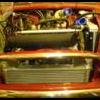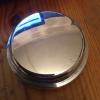Simple question i think for those that know whats what...
These 'Billet Oil Filter Housings' - as sold by minispares etc, as written in the description.. 'the bypass valve omitted for increased safety' ... 'but should be used with our braided hose kit for safety'
What does the bypass valve do in the first place and why is it safer to take it out and use the braided hose...?
cheers

Billet Oil Filter Housing
Started by
screech
, Apr 04 2011 09:40 PM
7 replies to this topic
#1

Posted 04 April 2011 - 09:40 PM
#2

Posted 04 April 2011 - 09:49 PM
when the engine is cold ot lets the oil bypass the filter so yo can get nice dirty oil running through the bearings.
with the billet housings you should take more care letting the engine warm up, but you sholdnt be pasting a cold engine anyway...
with the billet housings you should take more care letting the engine warm up, but you sholdnt be pasting a cold engine anyway...
#3

Posted 04 April 2011 - 09:49 PM
The bypass valve is a valve built into the filter head that bypasses the filter element if the filter gets so clogged that it's not allowing enough oil flow to the engine and so starving it. When this is open, the engine will at least still get oil but it is unfiltered oil. In reality if the filter is changed often enough there is very little chance of it getting that clogged up.
The oil delivery pipe on 12A type engines is sealed into the block and filter head using olives rather than a banjo or threaded fittings. It's not a type of connection that stands up to the pressure developed in the oil system well given the materials used in the construction of the pipe. It's a steel pipe, the olive doesn't hold it properly. The pipes do every now and then just pop out of the front of the block under pressure, very bad times.
The oil delivery pipe on 12A type engines is sealed into the block and filter head using olives rather than a banjo or threaded fittings. It's not a type of connection that stands up to the pressure developed in the oil system well given the materials used in the construction of the pipe. It's a steel pipe, the olive doesn't hold it properly. The pipes do every now and then just pop out of the front of the block under pressure, very bad times.
#4

Posted 05 April 2011 - 10:05 AM
Safer is a little strong though....
If the filter is clogged then how much oil gets to the engine ???
Personally I would rather dirty oil get to my bearings than no oil at all
These filter heads were developed for race engines, and are to avoid the condition where the spring is too weak to close the valve, however a race engine should be getting new oil and a filter at every race.
On the other hand your road car will be getting a filter change every 3000 + miles.
If the filter is clogged then how much oil gets to the engine ???
Personally I would rather dirty oil get to my bearings than no oil at all
These filter heads were developed for race engines, and are to avoid the condition where the spring is too weak to close the valve, however a race engine should be getting new oil and a filter at every race.
On the other hand your road car will be getting a filter change every 3000 + miles.
#5

Posted 05 April 2011 - 10:14 AM
i was looking at these the other day and was wondering the same thing. so whats the verdict then, are they worth it or not?
#6

Posted 05 April 2011 - 10:19 AM
Personally I would rather dirty oil get to my bearings than no oil at all
Yes I completely agree. Dirty oil means the shells could be ruined and you might need a light regrind. No oil means you need a new engine.
Personally I don't think they are worth it. They don't address the real issue with the late filter head housing either because the main problem is the small gasket sealing area that leads to leaks where the gasket material can easily break away. An earlier, larger based filter head is a better upgrade.
#7

Posted 05 April 2011 - 10:34 AM
Here is a cheap and highly effective fix to the filter head housing spring loaded ball bypass valve. Its an old racer trick from the 1960s.
Remove the filter head and poke out this valve. Tap the hole 5/8 UNF and fit a 5/8 UNF bung, coating the threads with Loctite thread sealer. Costs pennies, problem solved. Just ensure a good mating surface between the filter head and block face, or as suggested earlier, get an earlier filter head.
Remove the filter head and poke out this valve. Tap the hole 5/8 UNF and fit a 5/8 UNF bung, coating the threads with Loctite thread sealer. Costs pennies, problem solved. Just ensure a good mating surface between the filter head and block face, or as suggested earlier, get an earlier filter head.
#8

Posted 05 April 2011 - 10:43 AM
Depends how you define fix really...
1 user(s) are reading this topic
0 members, 1 guests, 0 anonymous users

















